Werner Bessei is Professor emeritus of the University of Hohenheim, Suttgart, Germany. His field of specialisation is the influence of management and genotype on behaviour, welfare and performance of laying hens, broilers and turkeys. He is Editor of Lohmann Information since 2019.
Abstract
In the debate on the welfare of broilers and turkeys environmental enrichment has become a major issue. Most label production programs request occupation objects in addition to litter. Diverse methods of enrichment have recently been developed and tested. Enrichment strategies aim at increasing the intensity and variability of behaviours. They include different materials, such as perches, raised platforms, vertical panels inside the pens, pecking devices and various feeding and lighting programs. Raised platforms are preferred over perches in fast growing breeds. Stimulation of foraging activities through the presentation of supplementary whole grain feeding shows little effect as long as compound feed is available. The use of perches and raised platforms declines with age. Nevertheless even fast growing breeds of broilers and turkeys show the motivation to use raised levels for resting, especially during night. Enrichment tends to improve activity and to reduce leg problems. The acceptance of devices which are expected to stimulate pecking activities, such as hay and straw baskets, pecking blocks, strings and plastic objects is highly variable and the birds’ interest often declines after a short time. Temporary presentation of enrichment devices and/or simultaneous presentation of different enrichments increase the interest and response of the birds to these stimuli. Special feeding programs, such as sequential presentation of different diets and light programs can stimulate the activity and improve the leg conditions. Enrichment in broilers and turkeys has obviously no significant effect on performance. First cost estimates for different enrichment measures used in commercial turkey farms varied between 0.12 and 0.68 € per bird. Growing information on various forms of enrichment enables farmers to select the most suitable forms for given management systems.
Keywords:
Broilers, turkeys, enrichment, welfare, economics
Introduction
Broilers and turkeys are traditionally kept under monotonous environmental conditions, which compromise bird welfare due to inactivity, restriction of the behavioural repertoire and various health hazards. Recent development of welfare labels request enrichment devices in order to stimulate the expression of a wide spectrum of behaviours and to improve the physical and psychic conditions of the birds. Consequently there has been a rapid development of studies on environmental enrichment in boilers from the 1990s onwards. A literature search for reviewed scientific articles on “environmental enrichment” and “broilers” using Scopus showed a sharp progression from 2016 onwards (Figure 1). 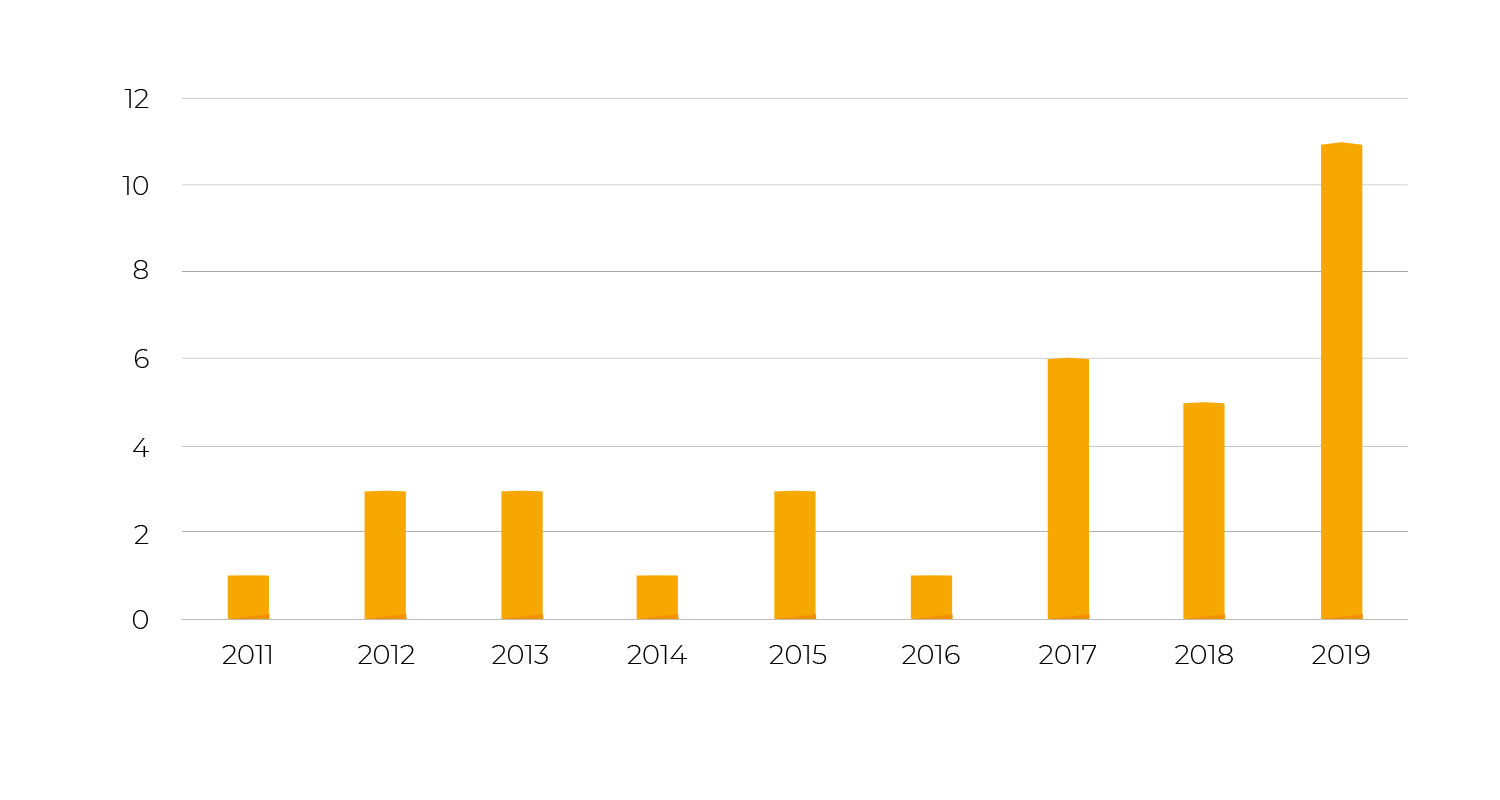
Figure 1. Number of published articles in reviewed scientific journals from 2011 to 2019 (Scopus search, February 2020)
It is generally accepted that adequate external stimuli are a prerequisite for normal physiological and psychological development of humans and animals. Deprivation of stimuli impairs the neuronal organisation of the nervous system and causes serious behavioural problems (Prescott, 1971). Experiments with primates have shown that lack of somatosensory stimulation leads to unsocial behaviours, problems to experience positive emotions and – under extreme conditions – to death. Lack of environmental stimulation can also produce behavioural stereotypies. ntensive husbandry systems for broilers and turkeys are charcterized by uniform, barren environment, but provide more stimuli than the experiments under which the above-mentioned problems have been demonstrated. Nevertheless, many behavioural problems of farm animals are considered the result of the monotonous environment. Physical restriction and lack of structural elements of the environment does usually not allow full expression of the behavioural repertoire shown under natural conditions. Whether the expression of the full behavioural inventory is essential for the welfare of the birds is still debated among scientists. It is assumed that scratching, dustbathing, exploration (litter pecking and walking), and perching are indicators of wellbeing (Riber et al., 2017). Dustbathing for instance is supposed to be important for the maintenance of the feather cover. Perching and fear responses are essential for the protection of in wild birds against predators. Foraging is an essential behaviour in free-living birds to find food. These behaviours have lost their function under husbandry conditions. In indoor systems, chickens are not exposed to adverse climatic conditions and predators and feed is provided regularly in feeders. The fact that chickens perform the above-mentioned behaviours, regardless of the prevailing environment, has led to the assumption that the performance as such of these behaviours may have a rewarding effect. This is the theoretical basis for so-called “behavioural needs”. Hence, provision of the opportunity for foraging, dustbathing and perching is considered essential for the wellbeing of domestic chickens. In the public opinion, animal welfare not only requires the availability of substrates, which allow natural behaviours. Welfare implies also the perception of positive emotions (Newberry, 1995). Positive emotions are difficult to assess. Indicators of positive emotions are play-like behaviours, such as frolicking with or without objects, sparring and positive social interactions. Environmental enrichment is assumed to stimulate these behaviours and, thus, improve welfare (Vasdal et al., 2019). Enrichment has also been shown to reduce fear as negative emotional state. Perches, shelter and loose strips seem to enhance the resilience of birds towards different stressors, such as loud heavy metal music and irregular light schemes (Zidar et al., 2018). Under enriched conditions the birds showed also more explorative behaviour, improved problem solving in a detour test and a “positive attitude” in a bias judgement test when exposed to stressors. Consequently, environmental enrichment has become an essential aspect of animal welfare regulations and particularly of voluntary welfare labels (Bessei, 2018). Enrichment measures should be attractive and stimulate desirable behaviours, prevent undesirable behaviours and damages, and finally, should be applicable under practical husbandry conditions (Jones, 2004). Various approaches of enrichment in broilers and turkeys include: structural equipment, lighting and feeding programmes. These programs aim at improving the variability of behaviours and stimulating locomotor activity. The latter is of special importance with regard to prevention of leg problems (Reiter and Bessei, 2009; Djukic et al. 2004). Provision of free range and a veranda showed positive effects on health and welfare in growing turkeys (Berk et al., 2018). Enrichment materials do not stimulate behavioural activities in all cases. Raised platforms and large straw bales, for example, enhanced resting and reduced locomotion in turkeys (Letzguss, 2010). Baxter et al. (2019a,b) did not find a positive effect of enrichment on play behaviour. There is a multitude of reports on different enrichment methods, which have been tested in experimental stations, and on commercial production units. However, there is still a lack of information on the practical application and the economics of enrichment for broilers (Riber et al., 2017). The present paper gives an overview of the most important enrichment systems and economical aspects of enrichment under commercial conditions.
Structural elements
Litter
Broilers and turkeys are usually kept on litter, which is considered as a basic means to allow exploration, scratching, pecking and dust bathing. The absence of litter was one of the most important arguments for the ban of conventional cages for laying hens. To be functional with regard to scratching and pecking behaviour, litter should be dry and friable. However, under practical conditions litter becomes often wet and sticky and does not provide adequate materials for behavioural stimulation. Wet litter has been recognized as main factor causing footpad dermatitis in broilers and turkeys (Mayne et al., 2007; Youssef et al., 2011). The establishment of special areas with dry sand increased the activity of broilers during the first weeks of live (Leterrier et al., 2001). This effect, however, disappeared at the end of the growing period. Various different types of litter, like wood shavings, peat, oat hulls and straw pellets have been tested as enrichment materials. Peat and oat hulls were found to be particularly effective in stimulating dust-bathing behaviour in broilers (Baxter et al., 2018). There was, however, no effect of litter as enrichment on the leg conditions.
Perches and raised platforms
Under natural conditions, chickens and turkeys perch on trees or on other raised places. This behaviour is an important means to escape predators while resting and sleeping. Hence perching is considered as essential behavioural requirement. It is generally acknowledged that domestic chickens and turkeys have a strong preference to use raised locations. The use of this enrichment equipment may enable the birds to escape from crowded, wet and poorly ventilated litter areas. Moving up and down in the different levels may also strengthen the skeleton system and reduce leg problems. While the installation of perches is compulsory for layers in EU countries, there is no legal regulation for broilers and turkeys so far. There is, however, increasing interest of welfare labels to present raised places for meat producing birds. Consequently this aspect is being dealt with by research institutes and practical broiler and turkey producers. Research aspects of elevated structures for broilers are presented in detail by J. Malchow in this edition (pages …). Attempts to solve the problems under practical conditions are presented in the following. Transport boxes or bags filled with litter materials may be used to provide raised places in broiler houses. Observations in commercial farms have shown that these places are frequently visited and used by the chicks for resting and pecking (Figure 2).

Figure 2 Chick`s transport boxes (left) and bags filled with straw pellets or other litter material (right) are being used as raised platforms
The material is worn down as the chicks grow older and the remaining is being integrated in the litter. Larger and more long-lasting platforms of wood or metal have been constructed for older broilers and turkeys (Figure 3 A,B).
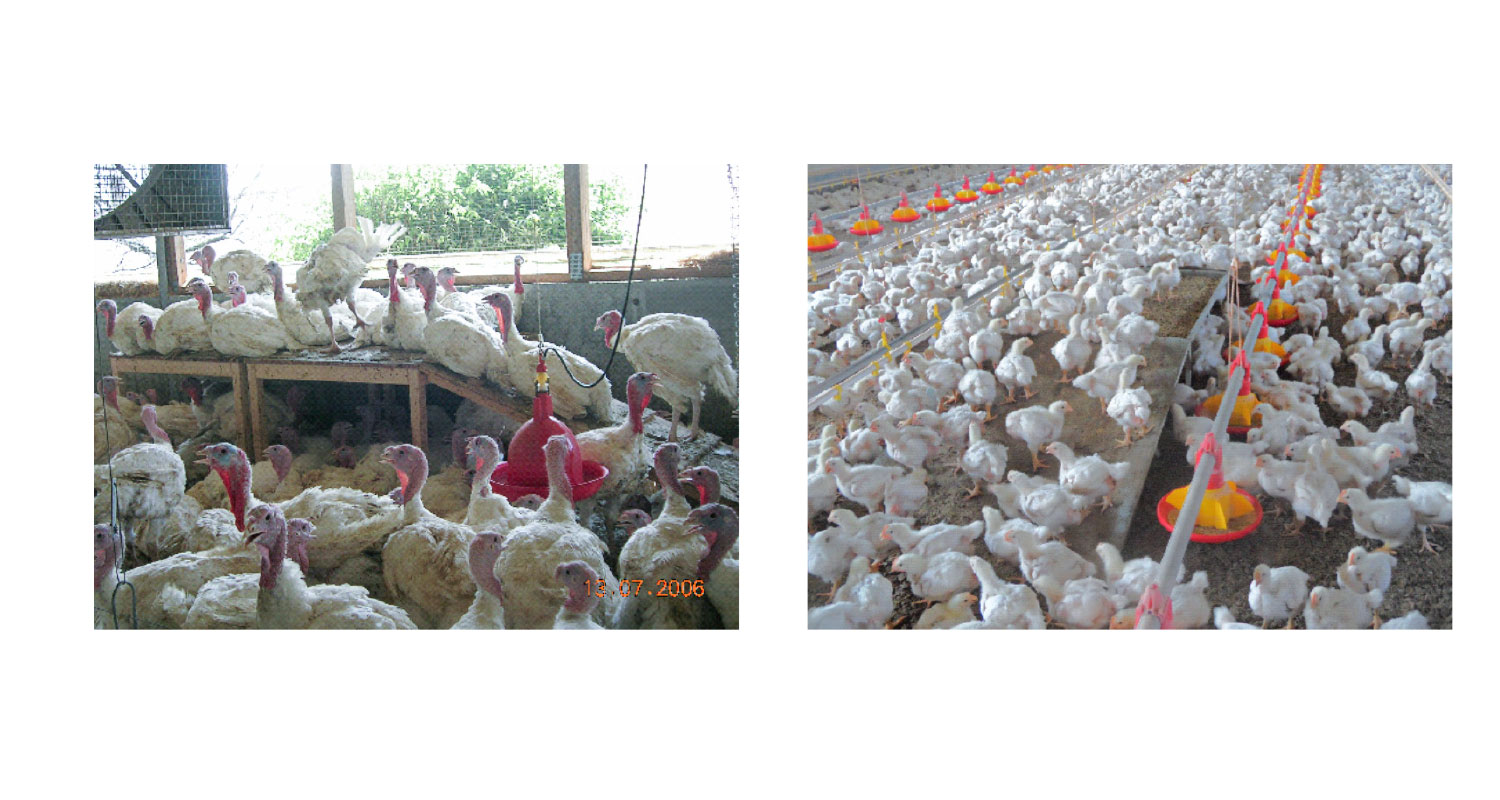
Figure 3 Raised platforms are used extensively by turkeys (left) and broilers (right) during day and night
Ramps are usually attached to facilitate access. These constructions have to be cleaned and disinfected after each flock. Large bales of straw are also used as raised locations by broilers and turkeys (Figure 4). They are integrated in the litter through pecking and scratching and the remaining is being removed with the litter. There is a controversial discussion whether raised platforms and straw bales fulfil the behavioural requirement of the birds for resting and sleeping (Schrader et al., 2016). Some authors argue that clasping around the perch is essential for adequate resting and sleeping (Figure 5). Other authors stress the importance of a raised locations, independent of the footing material, and raised platforms may fully substitute perches. This argument is supported by choice experiments which showed that heavy broilers and turkeys prefer platforms over perches (Norring et al., 2016; Malchow et al., 2018a; Strassmeier, 2007). There is a debate whether the additional space provided by platforms may be accepted as “available” space. This aspect is important from the economical and welfare point of view. The use of the raised areas may allow higher stocking rates of broiler and turkey houses, and thus, reduce housing costs. In most welfare programs this space has to be provided as supplement to the minimum available space. The area underneath the platforms can be used by the subordinate birds to escape from aggressive attacks of dominant pen mates and thus contributes to their welfare (Figure 6).
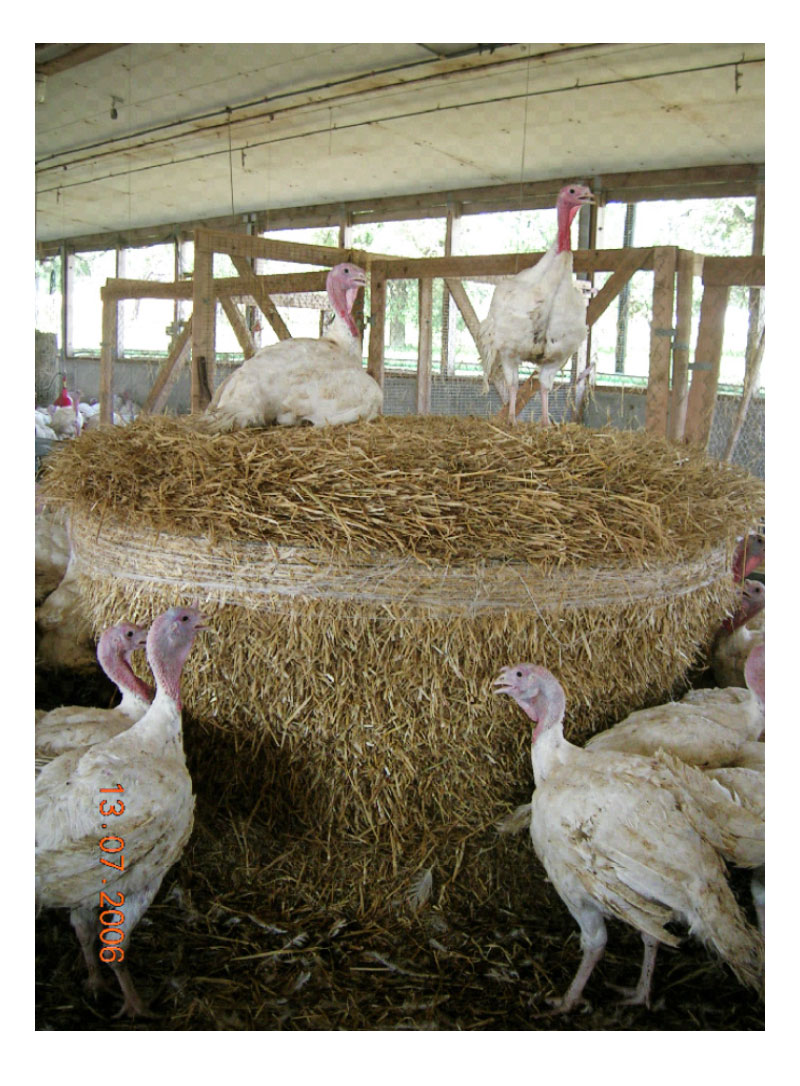
Figure 4 Large straw bales are being used for perching and pecking
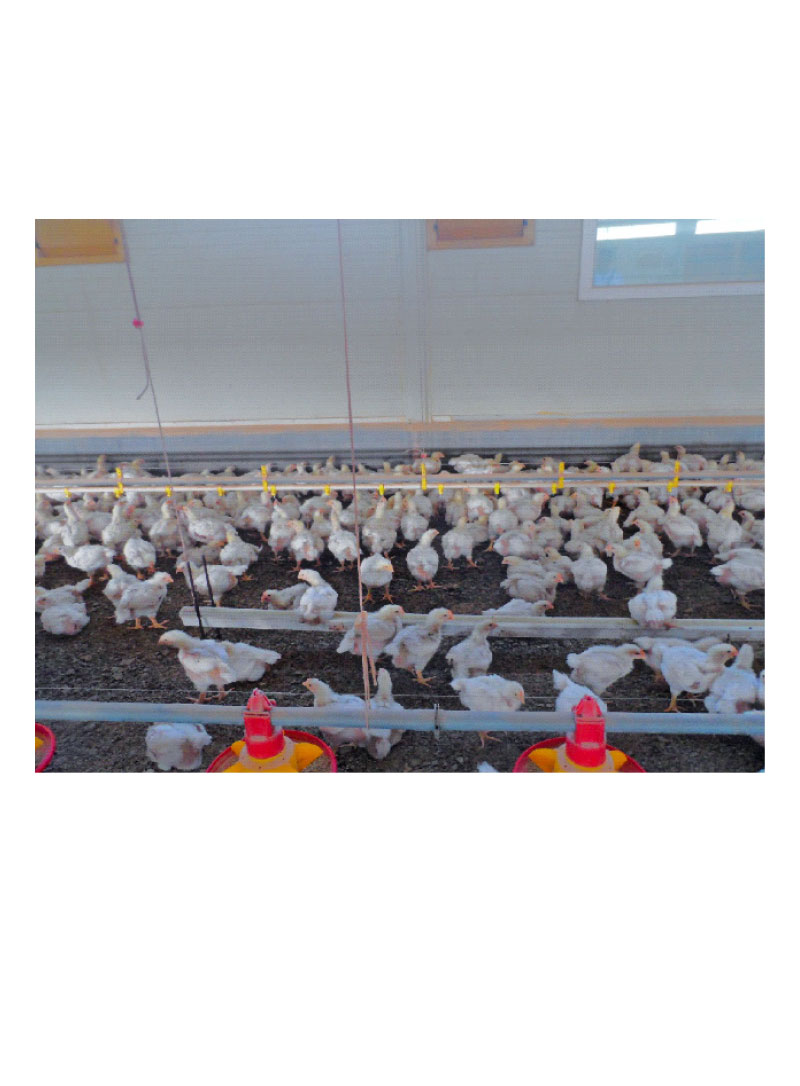
Figure 5 Suspended plastic perches allow the birds to clasp around the perch and can be adapted to size of the birds

Figure 6 Space underneath the platform is used by subordinate birds to avoid aggressive pecks
There is no general rule concerning the minimum height of perches or platforms. Malchow et al. (2018b) tested the preference of different broiler breeds for perches and grids at heights of 10, 30 and 50 cm. The highest level was the most preferred. Berk and Hahn (2000) reported that growing turkeys made better use of perches at intermediate height of 40 cm versus 20 and 60 cm height. Davies and Weeks (1995) could increase the use of perches by broilers when their height was continuously adjusted to the size of the birds. Sloped designs where one end of the perch is on ground level and the other end is raised enable the birds of different size to access the perch and to choose their preferred height (Figure 7). Scholtyssek and Grashorn (1989) used symmetric ramps with an integrated perch on the highest point. This perch was used intensively for resting. Moving up and down between different levels may improve the condition of wings and leg bones. The use of raised locations, however, bears risks of developing dermatitis of the breast skin and foot pads (Bokkers and Koene, 2003). The use of raised levels is restricted by the body weight and poor agility of fast growing birds. Therefore, the expected expression of positive and negative effects of this type of enrichment depends on the use of the enrichment devices. Perches were used by up to 20 % of the broilers, when perch height was continuously adjusted to the bird size (Davies and Weeks, 1995). In turkeys the use of perches varied between 1 and 10 % (Matrenchar et al., 1999). Reports on the effect of raised locations on welfare are not consistent. Mench et al. (2001) found improvement of the leg bones and the behaviour of broilers, which were given the opportunity of climbing and perching. Raised platforms improved gait scores significantly (Kaukonen et al., 2017), and ramps between feeders and drinkers improved the leg bone conditions of broilers (Scholtyssek and Grashorn, 1989). Positive results of raised platforms and straw bales as resting places on tibia bones of turkeys have also been reported by Letzguß (2010). Using similar enrichments, Cottin (2004) found better plumage scores and better walking ability in growing turkeys. In other studies, there were only minor or no effects of these structural enrichment components on welfare related criteria (Balog et al., 1997; Bizeray et al., 2002; Bench et al., 2016).

Figure 7 Broad perches which are raised at one end can be accessed by broilers from day-old
VERTICAL PANELS
Broilers prefer resting near walls. Based on this observation, vertical panels as structural enrichment elements have been tested (Newberry and Shackleton, 1997; Rodrigez-Aurrekoetxea et al., 2014; 2015). The panels led to more regular distribution of the birds over the whole pen and a better use of the central areas. Buijs et al. (2010) observed less disturbances of the birds by their pen mates through vertical panels. There was no effect of vertical panels on performance, footpad dermatitis and fluctuating asymmetry as indicators of stress. Farmers of label broiler production in France, who use suspended panels regularly, have confirmed this effect (personal communication; (Figure 8).
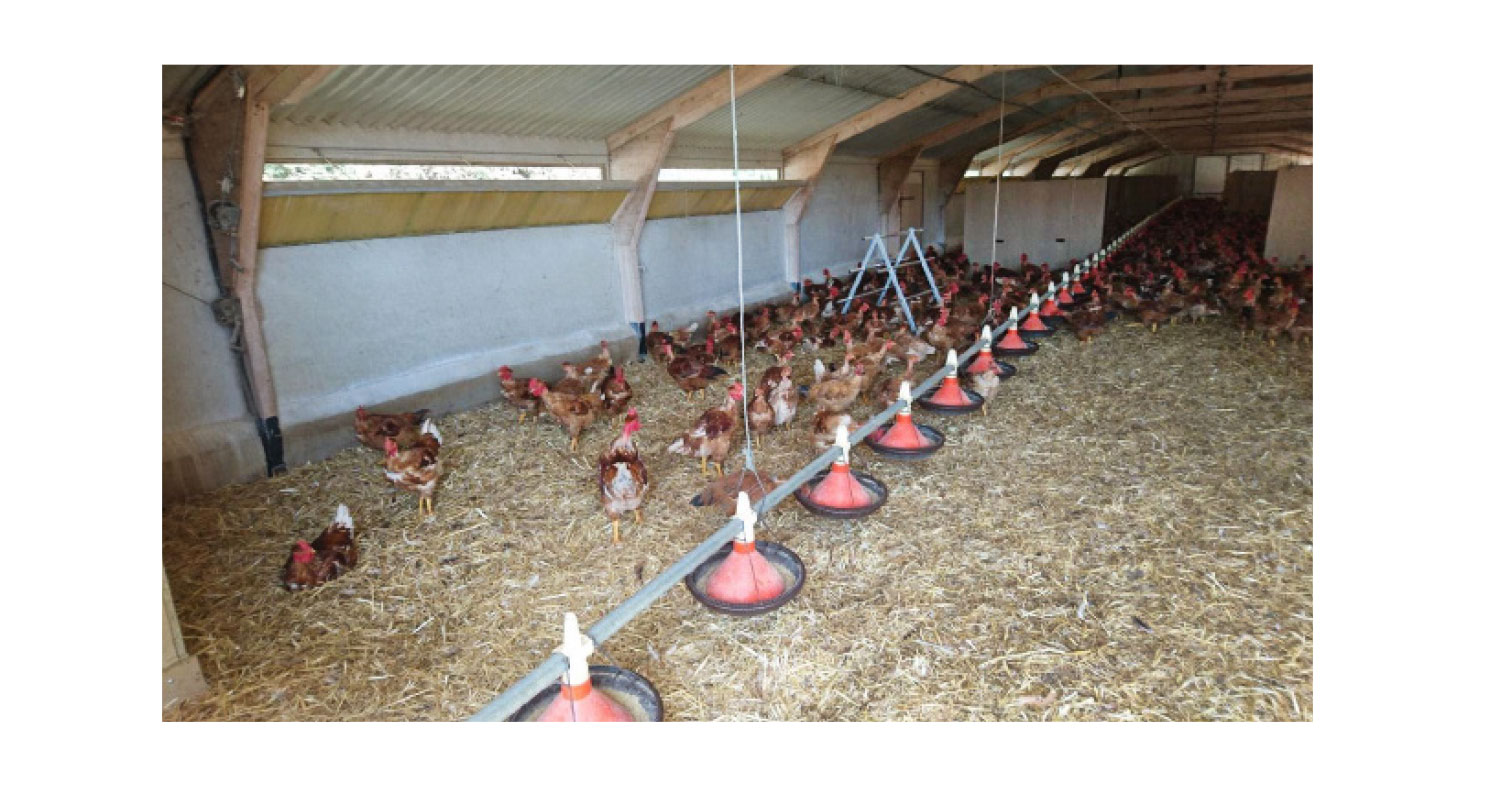
Figure 8 Vertical panels suspended from the ceiling lead to uniform distribution of broilers while resting
PECKING DEVICES
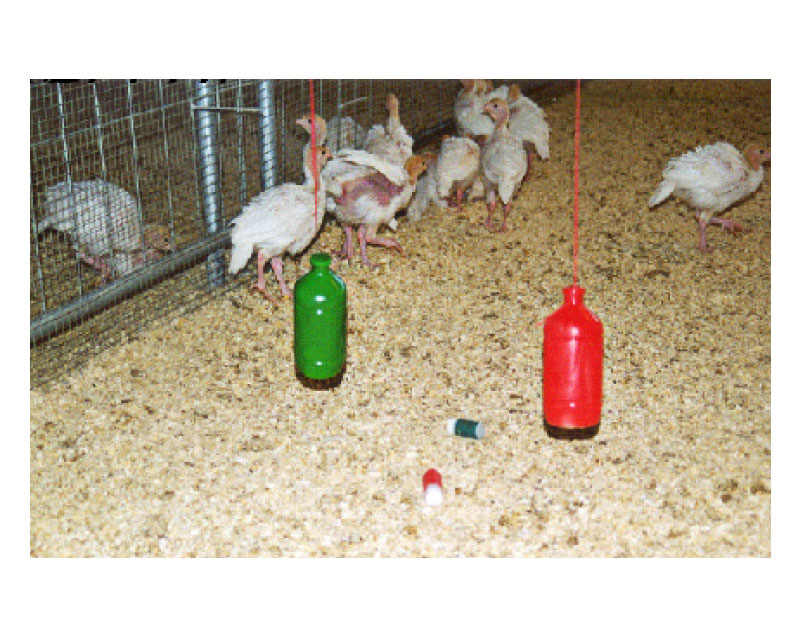
Figure 9 a,b Turkeys show little interest in coloured plastic bottles (top)blue cannisters (below) are highly atractive (by courtosy H. Meyer, Kartzfehen, Germany)
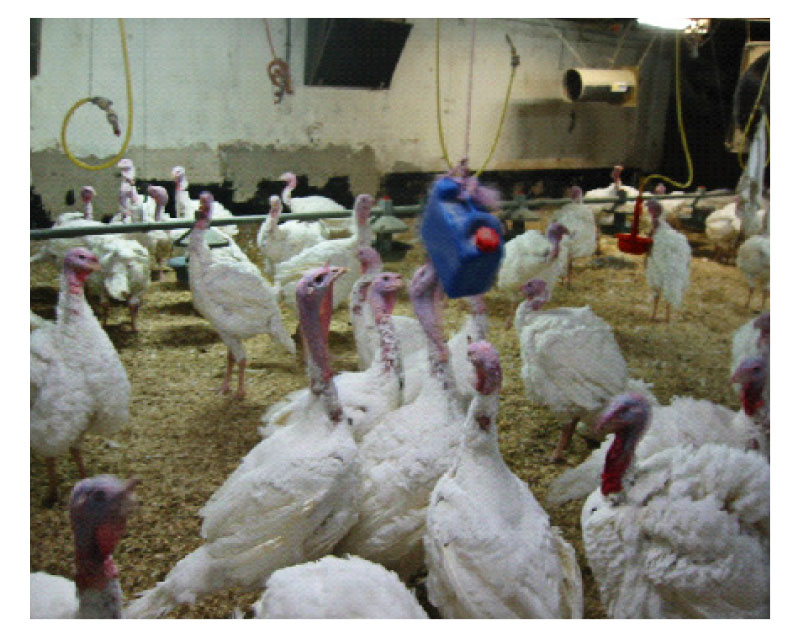
Figure 9 c,d Turkeys and broilers show littel interest in strings fixed at the feeder lines
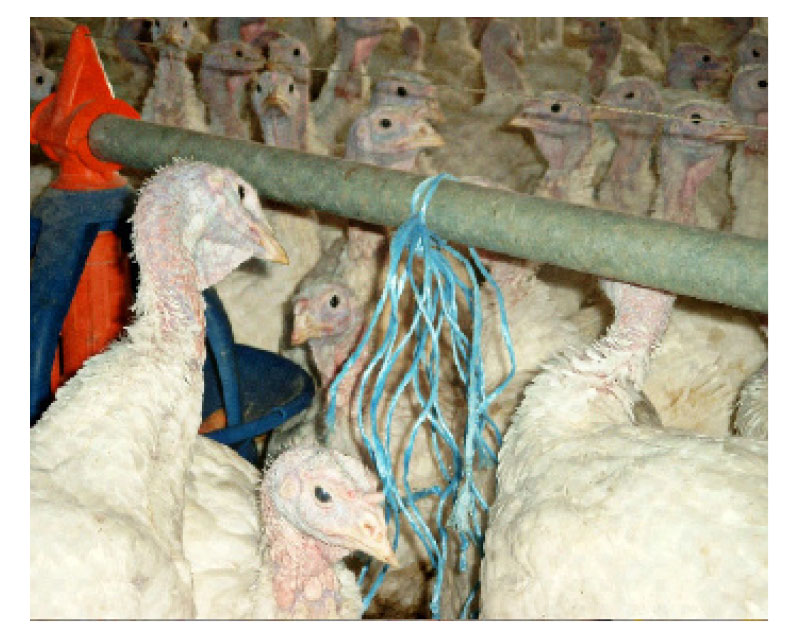
Figure 9c
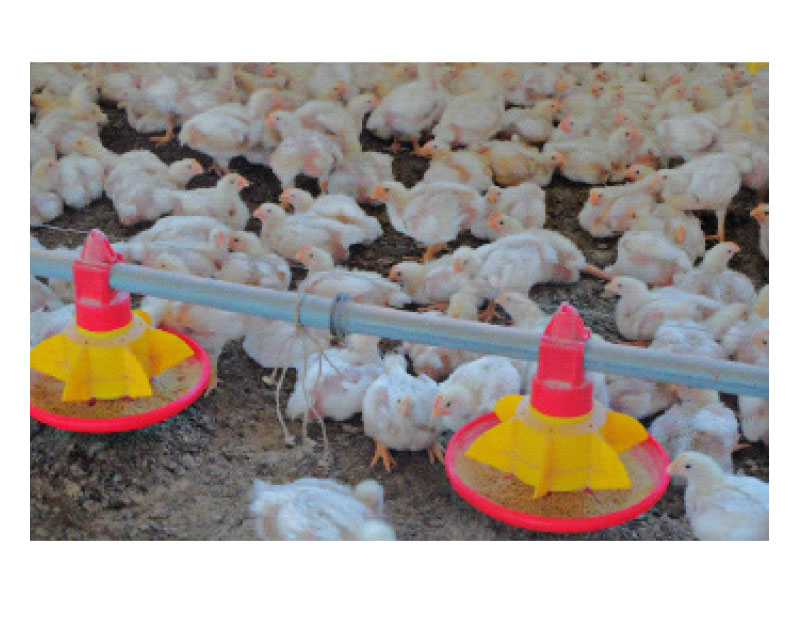
Figure 9d
While litter stimulates pecking as well as scratching and dustbathing behaviour, there exists a multitude of devices, which are designed to attract pecking behaviour only. This is supposed to reduce feather pecking and cannibalism in slow growing broilers and in turkeys (Sherwin et al., 1999; Crowe and Forbes, 1999). Strings, CD-discs, plastic bottles or canisters, baskets filled with hay or straw, straw bales or different other objects have been used experimentally or in commercial production systems (Figures 9 a – g). Laying hens use strings extensively as pecking objects. Broilers, in contrast, showed little interest (Bailie et al., 2018). The use of hay baskets has proved to be highly variable and there was no effect on feather pecking and cannibalism in turkeys (Letzguß, 2008). The interest of turkeys and broilers for enrichment objects is mainly driven by novelty, and the birds loose interest in the objects within a short time of continuous presentation. Therefore, it has been proposed to present the objects only temporarily and/or to frequently change the type of pecking objects. The presentation of edible objects has been considered more efficient in sustaining pecking of the objects. Pecking blocks containing whole grain have shown to be highly attractive for longer periods. They were used extensively by the birds and had to be replaced several times during the growing period.
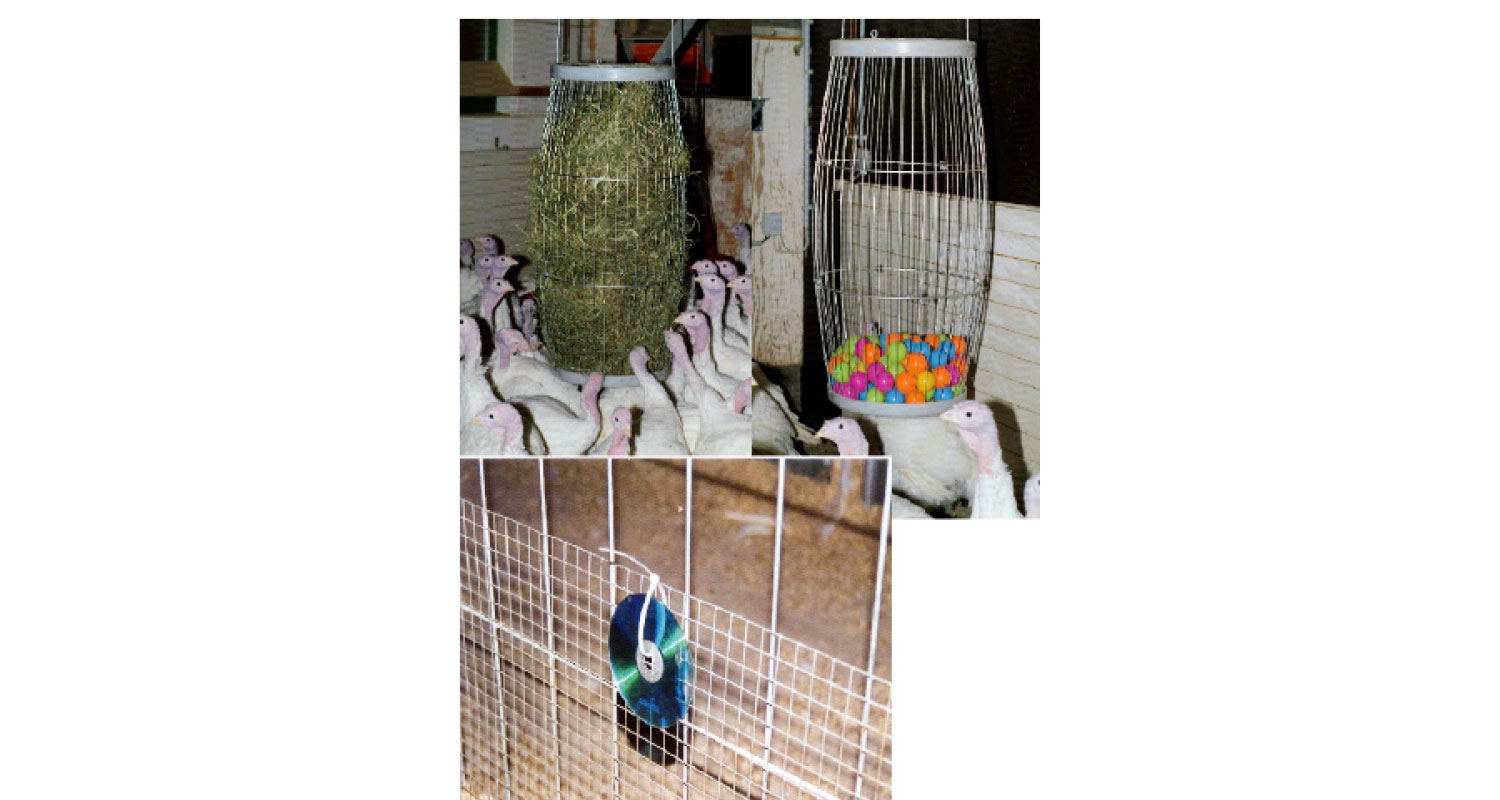
Figures 9 e,f,g Hay baskets stimulate pecking and eating; the same basket filled with multicolour plastic balls is ignored; CDs attract the attention of turkeys, the birds may, however, distroy through vigorous pecking
FEEDING PROGRAMS
Broilers are usually fed a uniform feed as pellets or crumbles, which leads to satiation in a short time. Therefore, attempts have been made to stimulate pecking, walking and scratching through distribution of whole grain as feed supplement in the litter. This method was not successful as long as pelleted feed was available in the troughs. Higher activity was achieved when the whole pelleted diet was scattered in the litter (Jordan et al., 2011). Pichova et al. (2016) have reported similar results. The distribution of whole wheat in the litter did not increase the activity of broilers. Only the distribution of highly attractive mealworms led to a short term increase of activity. In turkeys the presentation of whole wheat grain reduced feather pecking (Berk et al., 2017). Sequential feeding is another method to enrich the environment through feeding. Bizeray et al. (2001) fed diets differing in lysine content in the morning and in the afternoon. This system increased litter pecking and walking activity. Unfortunately, growth was negatively affected. Reiter and Bessei (2009) increased the distance between feeder and drinker from 2 to 12m. Performance criteria were not impaired, mortality was reduced by 2 % and leg conditions were improved. The latter effect was obviously due to an increased locomotor activity.
LIGHT
In the past, continuous light or quasi-continuous light (23 h light : 1 h dark) was the standard lighting program in most windowless broiler houses. It resulted in a low level of locomotor and feeding activity throughout the 24 hours period. This program has shown highest performance in earlier broiler breeds (Morris et al., 1967). However, continuous and quasi-continuous light prevent the development of circadian rhythms and cause enlargement of the eyeballs. Intermittent lighting programs using alternating short light and dark periods, such as 2 h light : 2 h dark, or 1 h light : 3 h dark, show similar effects as continuous light (Onbasilar et al., 2007; Olanrewaju et al., 2018). Interruption of the light phase through extended dark periods clearly improved the leg conditions but reduced growth rate, especially in short growing periods. The reduced growth could only be compensated with extended growing time (Thomsen, 1989). Schwean-Lardner et al. (2013) showed that in modern broiler lines periods of 4 to 8 hours of continuous darkness not only prevent the above-mentioned negative effects on welfare but also represent optimum conditions for growth and feed conversion. Meyer et al. (2019) presented a novel method of enrichment using laser light. Red laser dots were projected on the floor of broiler pens 4 times a day for four minutes. This procedure stimulated physical activity of the birds. There was no effect on walking ability.
COMBINATION OF ENRICHMENT ELEMENTS
The combination of different enrichment devices increases the environmental complexity and may show a higher impact on welfare related criteria than single enrichment devices. Hence, several welfare programs for broilers and turkeys require different types of enrichment simultaneously. The combination of several enrichment elements has been studied in recent experiments. The results are, however, not consistent with regard to welfare criteria. The availability of day light and straw bales did not reduce the interest in supplementary stimuli like strings (as pecking devices) and perches (Bailie and O`Connell 2014). The combination of strings and perches actually caused a reduction in locomotor activity, whereas the walking ability was slightly improved. Perches and dustbathes combined showed no effect on activity and play behaviour, but reduced fearfulness in broilers more efficiently than raised platforms only (Baxter et al., 2019). Oat hulls as supplementary enrichment to straw bales improved the gait score in broilers, but showed no effect on the activity of broilers (Baxter et al., 2018). Vasdal et al. (2019) provided broilers with peat (as preferred substrate for dustbathing), bales of alfalfa hay and elevated platforms. The enriched birds showed higher activity in various different behaviours and there was a non-significant tendency of improvement in gait score. The combination of peat and raised platforms reduced fearfulness, but showed no effect on the activity level and play behaviour. Light seems to play a particular role in combination with enrichment. Combination of wood shaving bales, perches and pecking devices reduced the activity of commercial broilers in conventional windowless houses as compared with an un-enriched control in conventional window-less broiler houses (de Jong and Ginnink, 2019). Positive effects of enrichment on the behavioural activities, such as exploration, foraging and walking, were only observed in combination with natural light. This confirmed earlier reports of Bailie et al. (2013), where the effect of natural light on gait score was greater in commercial broilers than the effect of straw bales. The combination of straw bales and natural light showed significantly longer latency to lie than straw bales in windowless conditions. The stimulating effect of combined enrichment (perches, pecking stones and straw bales) on locomotion, foraging and comfort behaviour of commercial broilers may have been due to access to natural.
Economics of enrichment
There is little information on the economics of enrichment in commercial broiler production. Goczik et al. (2017) estimated the economic effect of six different enrichment methods in broilers using a normative economic model. Three of the enrichment methods, meal feeding, sequential feeding and feeding whole wheat showed a higher gross margin and net return on management than the unenriched production system. It was assumed that the enrichment procedures reduced leg problems and mortality. On the basis of practical experience, the costs of enrichment in a flock of 4000 male turkeys has been estimated by Glawitz et al. (2014; unpublished). The results are shown in table 1. All enrichment objects are available commercially and average market prices have been used for the calculation. The amount of objects or material is not standardized so far. It varies in the present calculation from 25 pecking blocks to 8 large hay baskets for a flock of 4000 male turkeys. According to recommendations of an animal welfare program in Germany the minimum requirement is one enrichment object for 400 m² and 150 m² pen area in turkey and broiler pens respectively. As assumed in the present economic calculation, pecking blocks may stay for the whole growing period. In some cases, however, they are consumed within a few weeks and have to be replaced. This will increase costs for labor and material. The same concerns the supply of hay and straw in baskets or nets. The consumption of these materials is highly variable and the frequency of re-filling the baskets or nets is difficult to predict, should hay and straw be continuously available. Depending on type of enrichment extra labor costs for enrichment in a turkey pen with 4000 male birds ranged between 0.25 and 0.1 manpower-hours. This resulted in total costs per bird for enrichment between 0.12 and 0.68 €: the lower costs were calculated for straw “on demand” presented in nets, and the highest costs for pecking blocks and hay given continuously in baskets. Since enrichment is considered to positively influence the development of the birds, it has frequently been suggested that the higher costs for enrichment may be balanced by improved performance. In the above-cited references, however, enrichment had no or only marginal effects on economically important criteria, such as growth rate, feed efficiency, mortality and meat quality. Perches and raised platforms create additional space for the birds. Positive effects on the economics would be achieved when this space would be considered as usable space and allow higher stocking density per m² floor area. This procedure is, however, not accepted at present. To become economically viable, the higher costs have to be covered by higher market prices.
Table 1. Costs of enrichment on the basis of preliminary experience. The costs (EUR) of various enrichment devices for turkeys have been estimated by Glawitz (2014 unpublished)
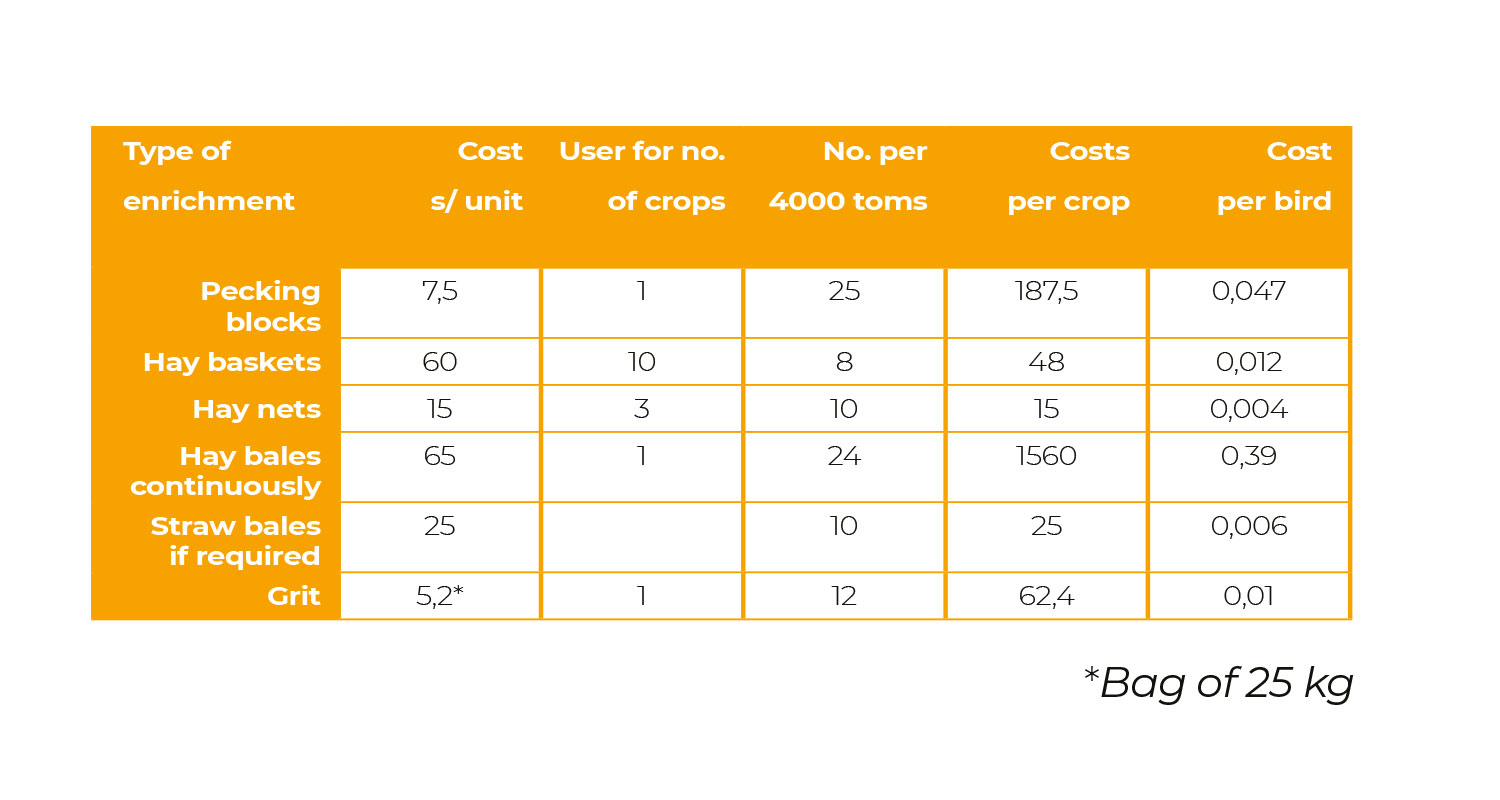
Conclusions
Enrichment of the environment has become an important argument in the discussion of broiler and turkey welfare. A multitude of different methods of enrichment have been developed and tested in experimental and commercial units. Enrichment can stimulate active behaviours, reduce fear and improve leg conditions. However, enrichment measures do not show positive effects on performance criteria. Introducing equipment and material for enrichment represents hygienic risks and additional costs. These costs cannot be balanced through savings in economically relevant criteria. The future will show to what extent retailers and consumers will be prepared to pay a higher price for broiler and turkey meat from enriched husbandry systems.
References. Bailie, C. L., C. Ijichi and N. E. O’Connell (2018) Effects of stocking density and string provision on welfare-related measures in commercial broiler chickens in windowed houses. Poultry Science 97:1503–1510. DOI: 10.3382/ps/pey026. Balog, J. M., G. R. Bayyari, N. C. Rath, W. E. Huff and N. B.Anthony (1997) Effect of intermittent activity on broiler production parameters. Poult. Sci. 76: 6. Baxter, M., C. L. Bailie and N. E. O’Connell (2018) Evaluation of a dustbathing substrate and straw bales as environmental enrichments in commercial broiler housing. Appl. Anim. Behav. Sci. 20: 78–85. DOI: 10.1016/j.applanim.2017.11.010. Bench, C. J., M. A. Oryschak, D. R. Korver and E. Beltranena (2016) Behaviour, growth performance, foot pad quality, bone density, and carcass traits of broiler chickens reared with barrier perches and fed different dietary crude protein levels. Canadian Journal of Animal Science 97: 268–280. DOI: 10.1139/cjas-2015-0202. Berk, Jutta and Gisela Hahn (2000) Aspects of animal behaviour and product quality of fattening turkeys influenced by modified husbandry. Archiv für Tierzucht 43 (3 SPEC. ISS) 189–195. http://www.scopus.com/inward/record.url?eid=2-s2.0-23644447912&partnerID=40&md5=2913309a676821db51f751a54e1480a0. Berk, Jutta, Eva Stehle and T. Bartels (2017) Relationship between light quality, environmental enrichment and injurious pecking in turkeys. Xth European Symposium on Poultry Welfare. Ploufragan, France. https://www.openagrar.de/receive/openagrar_mods_00026665. Bessei, W. (2018) Impact of animal welfare on worldwide poultry production. World’s Poultry Science Journal 74: 211-224. Bizeray, D., C. Leterrier, P. Constantin and J. M. Faure (2001) Sequential feeding with low lysine diet induces higher level of activity in meat-type chickens. Proc. 6th Europ. Symp. Poultry Welfare, Zollikofen, Switzerland, 173–176. Bizeray, D. C. Leterrier, P. Constantin, M. Picard and J. M Faure. (2002) Sequential feeding can increase activity and improve gait score in meat-type chickens. Poult. Sci. 81: 1798–1806. http://www.scopus.com/inward/record.url?eid=2-s2.0-0036988280&partnerID=40&md5=b9f562d1becdf504798cbfbb6f78a5a7. Bokkers, E.A.M. and P. Koene (2003) Behaviour of fast- and slow growing broilers to 12 weeks of age and the physical consequences. App. An. Behav. Sci. 81: 59–72. DOI: 10.1016/S0168-1591(02)00251-4. Buijs, S., L. J. Keeling, C. Vangestel, J. Baert, J. Vangeyte and F.A.M. Tuyttens (2010) Resting or hiding? Why broiler chickens stay near walls and how density affects this. Applied Animal Behav. Sci. 124: 97–103. DOI: 10.1016/j.applanim.2010.02.007. Cottin, E. (2004) Einfluss von angereicherter Haltungsumwelt und Herkunft auf Leistung, Verhalten, Gefiederzustand, Beinstellung, Lauffähigkeit und tibiale Dyschondroplasie bei männlichen Mastputen. Diss. Univ. Hannover. Crowe, R. and J. M. Forbes(1999) Effects of 4 different environmental enrichment treatments on pecking behaviour in turkeys. Brit. Poultry Sci. 40: 11–12. Davies, H. C. and C. A. Weeks (1995) Effects of age and leg weakness on perching behaviour of broilers. Brit. Poult. Sci. 36: 838. Djukic, M., A. Harlander-Matauschek and W. Besse (2004) The effect of weight load on the legs on locomotor activity and resting behaviour of fast and slow growing chickens. Proc. 38th International Congress of the ISAE, Helsinki, Finland. Gocsik, É.; Silvera, A. M.; Hansson, H.; Saatkamp, H. W.; Blokhuis, H. J. (2017): Exploring the economic potential of reducing broiler lameness. In: Br. Poult. Sci. 58 (4), S. 337–347. DOI: 10.1080/00071668.2017.1304530. Jones, R. B. (2004) Environmental enrichment: the need for practical strategies to improve poultry welfare. In: Perry, G.C. (Ed.), Welfare of the laying hen. Papers from the 27th Poultry Science Symposium of the WP SA (UK Branch), Bristol, UK, July 2003. CABI Publ. Jordan, D., I. Štuhec and W. Bessei (2011) Effect of whole wheat and feed pellets distribution in the litter on broilers’ activity and performance. Arch.Geflugelkunde 75: 98–103. http://www.scopus.com/inward/record.url?eid=2-s2.0-80053058881&partnerID=40&md5=3c1ba5bfd3df614d9adc3f2f80a4ea8f. Kaukonen, E., M. Norring, and A. Valros (2017) Perches and elevated platforms in commercial broiler farms: use and effect on walking ability, incidence of tibial dyschondroplasia and bone mineral content. Animal 11: 864–871. DOI: 10.1017/S1751731116002160. Leterrier, C., C. Arnould, D. Bizeray, P. Constantinand J. M. Faure (2001) Environmental enrichment and leg problems in broiler chickens. Br.Poult.Sci. 42 (SUPPL. 1): 13-14. Letzguß, Helga (2010) Einfluss von Beschäftigungs- und Strukturelementen auf das Verhalten und das Beinskelett konventionell gehaltener Mastputen. Diss. Univ. Hohenheim, Germany. http://opus.uni-hohenheim.de/volltexte/2010/477. Malchow, J., J. Berk, B. Puppe and L.Schrader (2018) Perches or grids? What do rearing chickens differing in growth performance prefer for roosting? Poultry Science 8:1715. DOI: 10.3382/ps/pey320. Malchow, Julia, Jutta Berk and L. Schrader (2018) Use of perches and grids during light and dark period by growing chickens differing in growth intensity. Proc. XVth European Poultry Conference: Dubrovnik, Croatia. https://www.openagrar.de/receive/openagrar_mods_00042482. Martrenchar, A., D. Huonnic, J. P. Cotte, E. Boilletot and J. P. Morisse (1999) Influence of stocking density, artificial dusk and group size on the perching behaviour of broilers. Br. Poult. Sci. 41:125–130. DOI: 10.1080/713654921. Mench, J.A., J. P. Garner and C. Falcone (2001) Behavioral activity and its effects on leg problems in broiler chickens. Proc. 6th Eur. Symp. Poult. Welfare. H. Oester and C. Wyss (ed.) World’s Poultry Science Association, Zollikofen, Switzerland, 152–156. Meyer, Meaghan M.; Johnson, Anna K.; Bobeck, Elizabeth A. (2019): A novel environmental enrichment device increased physical activity and walking distance in broilers. In: Poultry Science. DOI: 10.3382/ps/pez581. Morris, T.R. (1967) Light requirement of the fowl. In: Carter, T. C. (Ed.) Environmental control in poultry production, Edinburgh-London. Newberry, R.C. and D.M. Shackleton, (1997) Use of visual cover by domestic fowl. A Venetian blind effect? Animal Behaviour 54: 387–395. DOI: 10.1006/anbe.1996.0421. Norring, M., E. Kaukonen and A.Valros (2016) The use of perches and platforms by broiler chickens. App. An. Behav. Sci. 184, S. 91–96. DOI: 10.1016/j.applanim.2016.07.012. Olanrewaju, H.A., W.W. Miller, W.R. Maslin, S.D. Collier, J. L. Purswell and S.L. Branton (2018) Influence of light sources and photoperiod on growth performance, carcass characteristics, and health indices of broilers grown to heavy weights. Poult. Sci. 97:1109–1116. DOI: 10.3382/ps/pex426. Onbaşilar, E.E., H. Erol, Z. Cantekin and Ü. Kaya (2007) Influence of intermittent lighting on broiler performance, incidence of tibial dyschondroplasia, tonic immobility, some blood parameters and antibody production. Asian-Aus.J.Anim.Sci. 20: 550–555. DOI: 10.5713/ajas.2007.550. Pichova, K., J. Nordgreen, C. Leterrier L. Kostal and R.O. Moe (2016) The effects of food-related environmental complexity on litter directed behaviour, fear and exploration of novel stimuli in young broiler chickens. Appl.Anim.Behav.Sci. 174:83–89. DOI: 10.1016/j.applanim.2015.11.007. Prescott, J.W. (1971) Early somatosensory deprivation as an ontogenetic process in the abnormal development of the brain and behavior. In: Medical Primatology. I.E. Goldsmith and J. Moor-Jankowski (Eds.) S. Karger, Basel, Switzerland. Reiter, K. and W. Bessei (2009) Effect of locomotor activity on leg disorder in fattening chicken. In: Berl.Munch.Tierarztl.Wochenschr. 122: 264–270. DOI: 10.2376/0005-9366-122-264. Riber, A.B., H.A. van de Weerd, I.C. de Jong and S. Steenfeldt (2017) Review of environmental enrichment for broiler chickens. Poultry Science, pex344-pex344. DOI: 10.3382/ps/pex344. Rodriguez-Aurrekoetxea, A., E.H. Leone and I. Estevez (2014) Environmental complexity and use of space in slow growing free range chickens. App. An. Behav. Sci. 161:86–94. DOI: 10.1016/j.applanim.2014.09.014. Rodriguez-Aurrekoetxea, A., E.H. Leone, and I. Estevez (2015) Effects of panels and perches on the behaviour of commercial slow-growing free-range meat chickens. App. An. Behav. Sci. 165:103–111. DOI: 10.1016/j.applanim.2015.02.004. Scholtyssek, S. and M. Grashorn (1989) Laufböden in der Broilermast. Züchtungskunde 61: 152–163. Schrader, L., S. Dippel and C. Nicol (2016) Do laying hens have a motivation to grasp while night time roosting? In: Proc. 50th Congress of the International Society for Applied Ethology. Past and Future: Standing on the Shoulders of Giants; July 2016, Edinburgh, UK. https://www.openagrar.de/receive/openagrar_mods_00020822. Schwean-Lardner, K.; Fancher, B. I.; Gomis, S.; van Kessel, A.; Dalal, S.; Classen, H. L. (2013): Effect of day length on cause of mortality, leg health, and ocular health in broilers. In: Poult. Sci. 92 (1), S. 1–11. DOI: 10.3382/ps.2011-01967. Sherwin, C.M., P.D. Lewis and G.C. Perry (1999) Effects of environmental enrichment, fluorescent and intermittent lighting on injurious pecking amongst male turkey poults. Brit. Poult. Sci. 40: 592–598. http://www.scopus.com/inward/record.url?eid=2-s2.0-0033255550&partnerID=40&md5=d8e6ed13d5505f2931160316029d7627. Strassmeier, Petra (2007) Einfluss von Strukturelementen, Futterzusammensetzung und Witterung auf das Verhalten von gemischt gehaltenen BIG Six und Kelly Bronze Puten in der Auslaufhaltung. Diss. Tierärztl. Fak., LMU München, Germany. Thomsen, M. G. (1989) Lysprogammet og foderstructurens inflydelse pa slagtekyllingers adfaersmonster. In: Statens Husdyrbrugsforsog. Meddelse Nr. 736, Kopenhagen, Denmark.





















